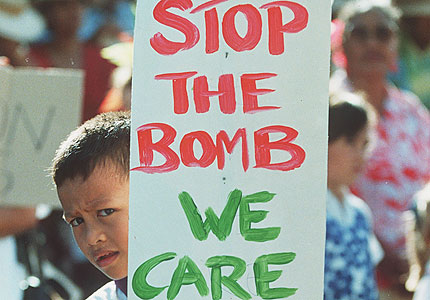
Protesters march against against French nuclear testing in the South Sea Islands in 1995
Halt nuclear weapons testing
One of the most effective ways to deal with the nuclear danger is to stop nuclear testing, which is why Greenpeace and other anti-nuclear groups campaigned so vigorously for a ban on testing in the 1980s and 1990s.
These protests, combined with the efforts of non-nuclear countries, led to the signing of the United Nations' Comprehensive Test Ban Treaty (CTBT) by all the declared nuclear weapon states in 1996. First proposed in 1954, and described as the "longest sought and hardest fought for arms control treaty in history", the Treaty has contributed to a complete end to nuclear testing since 1998, despite the fact that the US Senate subsequently refused to ratify it.
What it says
Nations signed up to the CTBT pledge "not to carry out any nuclear weapon test explosion or any other nuclear explosion". Every kind of nuclear explosion is prohibited, whatever its purpose. It provides for extensive verification, including an International Monitoring System to detect nuclear explosions, and on-site inspections may be requested by any signatory state if it suspects another of cheating.
Unfortunately, to enter into force the CTBT must be ratified by the 44 countries that in 1996 possessed nuclear research or power reactors. So far three nuclear capable states (India, Pakistan and North Korea) have refused even to sign the treaty, while many more (including the US and China) have refused to ratify it.
Breaking the spirit of the CTBT
The US, UK and France have devised a way around the CTBT - which while not breaking the exact 'letter' of the agreement, totally undermines the goal of the treaty to contribute to disarmament by stopping the development of new weapons.
This is being done by using supercomputers and giant lasers to model nuclear tests. These technologies are not actually needed for the government's stated goal of ensuring the 'safety and reliability' of existing nuclear weapons, but are essential if the UK is to try to modify existing, or build a new nuclear weapon without underground testing.
This high-tech means of developing new nuclear weapons is exactly what is currently under construction at AWE Aldermaston, Britain's bomb factory in Berkshire, at a cost of billions of pounds.
By developing this capacity the UK is demonstrating contempt for the goals of the CTBT. The reality is that the UK, together with the other countries at the top of the nuclear 'totem-pole', seems determined to stay there at all costs, and to play fast and loose with any laws aimed at limiting its power. This leaves the rest of the world running to catch up -- a situation which almost guarantees that the CTBT and the Nuclear Non-Proliferation Treaty (NPT), to which it is closely-linked, will continue to be undermined.
Moreover, top nuclear weapon scientists believe that ultimately it will be impossible for the UK to be certain that new or improved nuclear weapons will work without nuclear testing, thereby creating the pressure for the UK to break the CTBT. Unless urgent action is taken, we could see both these treaties fail, with the world descending into a nuclear free-for-all.

